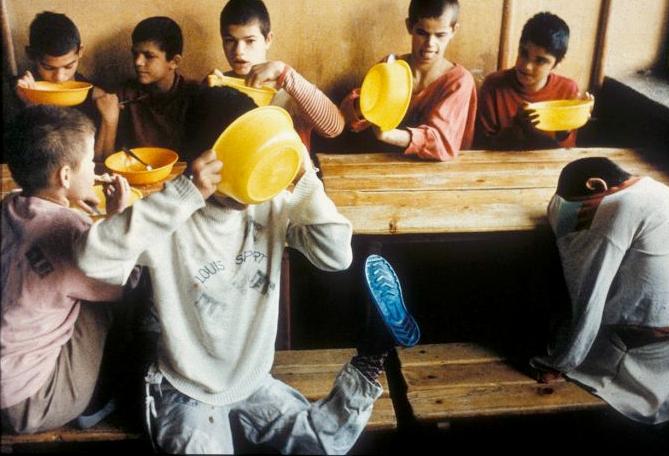
Romanian Gypsies: Historical Background--Communist Era (1945-89)

Figure 1.--Here girls eat lunch at a Romanian orphanage. Children like these were ommonly locked inside all day. With little or no stimulation. Most had no real close relatinships thriughout their childhood. As a result, one author explains, "Romania’s institutionalised children displayed profound developmental delays and abnormal social-emotional behaviour." [Silver] This of course was not only Roma childre, but the Roma population at these prphanages was out of all prortion to the theur share of the population.
|
|
Most Gypsies lived in Eastern Europe. After World War II, this mean that most European Gypsies came under the control of Communist regimes. The largest populations were in Romania, Bulgaria, Hungary, and Slovakia. Romania had the highest concentration of Gypsies. Communist authorities fully establishged ciontrol over the country (1948). From that point, Gypsies simply disappeared in official public documents. The primary Communist approach to Gypsies was forced assimilation. Gypsies in each Communist country were forced to speak required to speak the country's national language outside the home. They had to settle towns and work in new industrial jobs. The Romanian Government for the first three decadeds did not adopt policies specuficallt targetting Gypsies. But other policies such as requirements that people have settled addresses and formal jobs affected Gypsies more than other group because of their itinerate life styles and self employment. The Romanian authorities finally decided to address the social situation of the Gypsies and took policy actions specically targetting Gypies (late-1970s). It was, however, a secret decision. Even the demographic data the decisions were based on was kept secret. [Achim]
One author explains what happened during the Communist era, "Rather than producing well-adjusted citizens, the policy eroded time-honored Roma values and shattered the cohesiveness of their traditional communities. It left the new Roma generation prone to sexual, alcohol, and drug abuse, and filled state-run orphanages with deprived Roma toddlers." [Steves and Hewitt]
The weak economies developed as a result of the implementation of Marxist ideology meant that industrilization did not create the wealth that Western countries created. At the same time they signifficantly expanded the welfsre state, closing down private abd religious charioties and denying workers decent salaries so state welfare was vital. The Communist countries, however, with their weak economies could not adequtely fund the welfare system. And Gysies because of their poverty were a huge drag on the welfre system. And the forced assimilation essentially destroyed the Gypsy culture without replacing it with a new culture. Thr Gypsies did not truly integrate well into the national culture and were reviled by the local population to an extent that did nor exist before Communism. There were many forms of state sabctioned decrimination. The Gypsy population became prone to sexual, alcohol, and drug abuse as well as criminal behavior. A special problem was the number of infants and todlers left at Government orphanages. The poorly funded Romanian orphnages. This was not the case before Communism. Gypsys before Communism raised almost all of their children. And the Romnian opphnages became notorious hellholes for the ungortunte children entrusted to their care. Disturbing images reached the West of terribly deprived, scared children reached the est. One author writes, "Photos of infants with their heads shaved, chained to their cribs and lying in puddles of urine rocked the globe. Some 170,000 orphans were discovered crammed into 700 institutions. [Silver] Romanian like the Soviets believes that the new Socialist Man could be successfully raised in institutions. In Romania the perfect storm of failure was reached. The economic failure of Communism meant that many Romaniabs tyurned over their childen to the state. At he same time economic failure meant that resources were not provided to care for the children. And beaureacrats with no real attachment to the children ran the orphanages. Lrge numbrs of Roma children were raised in these orphanages. A whole generation of children were raised in thse terribly overcrowded, state-run orphanages. Children wre commonly locked up in beds and kept inside with no outdoor activity. These children grew up without care, social interaction, stimulation, or basic psychological comfort. As a result, "Romania’s institutionalised children displayed profound developmental delays and abnormal social-emotional behaviour." [Silver] This of course was not only Roma childre, but the Roma population at these prphanages was out of all prortion to the theur share of the population.
Sources
Achim, Viorel. "Chapter Six: The Roma in Romanian History," The Roma in Romanian History (Central European Press: Budapest, Hungary, 2018).
Silver, Katie. "Romania’s lost generation: Inside the Iron Curtain’s orphanages," ABC-RN (June 23, 1014).
Steves, Rick and Cameron Hewitt . "Eastern Europe's 'Gypsy question'".
HBC

Navigate the Boys' Historical Clothing Web Site:
[Return to the Main Romanian historical gypsy page]
[Return to the Main Romanian gypsy page]
[Return to the Main Romanian minority page]
[Return to the Main European gypsy page]
[Return to the Main Gypsy page]
[Introduction]
[Activities]
[Biographies]
[Chronology]
[Clothing styles]
[Countries]
[Bibliographies]
[Contributions]
[FAQs]
[Glossaries]
[Images]
[Links]
[Registration]
[Tools]
[Boys' Clothing Home]
Navigate the Boys' Historical Clothing national pages:
[Return to the Main Romanian page]
[Return to the Main countries page]
[Australia]
[Belgium]
[England]
[France]
[Germany]
[Ireland]
[Italy]
[Japan]
[Korea]
[Mexico]
[New Zealand]
[Scotland]
[United States]
Created: 11:09 AM 6/17/2018
Last updated: 11:09 AM 6/17/2018



